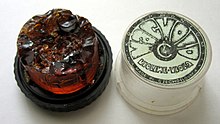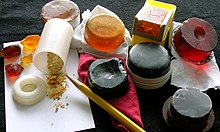Rosin

Rosin (
Properties

Rosin is
Rosin consists mainly of
Rosin is also sometimes used as internal reinforcement for very thin skinned metal objects - things like silver, copper or tin plate candlesticks, or sculptures, where it is simply melted, poured into a hollow thin-skinned object, and left to harden.
Prolonged exposure to rosin fumes released during soldering can cause occupational asthma (formerly called colophony disease[7] in this context) in sensitive individuals, although it is not known which component of the fumes causes the problem.[8]
The type of rosin used with bowed string instruments is determined by the diameter of the strings. Generally this means that the larger the instrument is, the softer the rosin should be. For instance, double bass rosin is generally soft enough to be pliable with slow movements. A cake of bass rosin left in a single position for several months will show evidence of flow, especially in warmer weather.
Prolonged exposure to rosin, by handling rosin-coated products, such as
Uses

Rosin is an ingredient in printing inks, photocopying and laser printing paper, varnishes, adhesives (glues), soap, paper sizing, soda, soldering fluxes, and sealing wax.
Rosin can be used as a
In industry, rosin is a flux used in soldering. The lead-tin solder commonly used in electronics has 1 to 2% rosin by weight as a flux core, helping the molten metal flow and making a better connection by reducing the refractory solid oxide layer formed at the surface back to metal. It is frequently seen as a burnt or clear residue around new soldering.
A mixture of pitch and rosin is used to make a surface against which glass is polished when making optical components such as lenses.
Rosin is added in small quantities to traditional linseed oil/sand gap fillers ("mastic"), used in building work.
When mixed with waxes and oils, rosin is the main ingredient of mystic smoke, a gum which, when rubbed and suddenly stretched, appears to produce puffs of smoke from the fingertips.
Rosin is extensively used for its friction-increasing capacity in several fields:
- Players of basses.
- Violin rosin can be applied to the banjolele, in order to prevent the bridge from moving during vigorous playing.
- Ballet, flamenco, and Irish dancers are known to rub the tips and heels of their shoes in powdered rosin to reduce slippage on clean wooden dance floors or competition/performance stages. It was at one time used in the same way in fencing and is still used as such by boxers.
- Rock climbershave used it in some locations.
- Olympic weightlifters rub the soles of their weightlifting boots in rosin to improve traction on the platform.
- It is applied to the traction.[citation needed]
- Bull riders rub rosin on their rope and glove for additional grip.
- Baseball pitchers and ten-pin bowlers may use a small cloth bag of powdered rosin for better ball control. Baseball players sometimes combine rosin with sunscreen, creating a very sticky substance that allows far more grip on the ball than the rosin alone will; the use of such a substance is a violation of Major League Baseballrules.
- Rosin can be applied to the hands in aerial pole dancingto increase grip.

Other uses that are not based on friction:
- Fine art uses rosin for tempera emulsions and as painting-medium component for oil paintings. It is soluble in oil of turpentine and turpentine substitute, and needs to be warmed.
- In a printmaking technique, aquatint rosin is used on the etching plate in order to create surfaces in gray tones.
- In archery, when a new bowstring is being made or waxed for maintenance purposes, rosin may be present in the wax mixture. This provides an amount of tackiness to the string to hold its constituent strands together and reduce wear and fraying.[citation needed]
- Dog groomers use powdered rosin to aid in removal of excess hair from deep in the ear canal by giving the groomer a better grip to grasp the hairs with.
- Some brands of fly paperuse a solution of rosin and rubber as the adhesive.
- Rosin is sometimes used as an ingredient in dubbing wax used in fly tying.
- Rosin is used hot to de-encapsulate epoxy integrated circuits.[14]
- Rosin can be mixed with beeswax and a small amount of linseed oil to affix reeds to reed blocks in accordions.
- Rosin potatoes can be cooked by dropping potatoes into boiling rosin and cooking until they float to the surface.[15]
Rosin and its derivatives also exhibit wide-ranging pharmaceutical applications. Rosin derivatives show excellent film forming and coating properties.[16] They are also used for tablet film and enteric coating purpose. Rosins have also been used to formulate microcapsules and nanoparticles.[17][18]
Glycerol, sorbitol, and mannitol esters of rosin are used as chewing gum bases for medicinal applications. The degradation and biocompatibility of rosin and rosin-based biomaterials has been examined in vitro and ex vivo.
Production


Rosin is the resinous constituent of the oleo-resin exuded by various species of pine, known in commerce as crude turpentine. The separation of the oleo-resin into the essential oil (spirit of turpentine) and common rosin is accomplished by distillation in large copper stills. The essential oil is carried off at a temperature of between 100 °C (212 °F)° and 160 °C (320 °F), leaving fluid rosin, which is run off through a tap at the bottom of the still, and purified by passing through straining wadding. Rosin varies in color, according to the age of the tree from which the turpentine is drawn and the degree of heat applied in distillation, from an opaque, almost pitch-black substance through grades of brown and yellow to an almost perfectly transparent colorless glassy mass. The commercial grades are numerous, ranging by letters from A (the darkest) to N (extra pale), superior to which are W (window glass) and WW (water-white) varieties, the latter having about three times the value of the common qualities.
Tall oil rosin is produced during the distillation of crude tall oil, a by-product of the kraft paper making process.
When pine trees are harvested "the resinous portions of fallen or felled trees like longleaf and slash pines, when allowed to remain upon the ground, resist decay indefinitely."[19] This "stump waste", through the use of destructive distillation or solvent processes, can be used to make products including rosin. This type of rosin is typically called wood rosin.
Because the turpentine and pine oil from destructive distillation "become somewhat contaminated with other distillation products",
On a large scale, rosin is treated by destructive distillation for the production of rosin spirit, pinoline and rosin oil. The last enters into the composition of some of the solid lubricating greases, and is also used as an adulterant of other oils.
The chief region of
The
The main source of supply in
Health effects
The fumes released during soldering have been cited as a causative agent of occupational asthma. The symptoms also include desquamation of bronchial epithelium.[21]
See also
Notes
- ISBN 978-3-527-30673-2.
- Perseus Project.
- Perseus Project.
- ^ "colophony". Oxford English Dictionary (Online ed.). Oxford University Press. (Subscription or participating institution membership required.) "ad. L. colophōnia (Pliny) for Colophōnia rēsīna resin of Colophon".
- ^ Nutrition, Center for Food Safety and Applied (2022-08-25). "Food Additive Status List". FDA.
- S2CID 94421680.
- ^ ""colophony disease", Archaic Medical Terms List, Occupational, on Antiquus Morbus website". Archived from the original on 2011-09-03. Retrieved 2007-03-13.
- ISBN 0-7176-1383-6
- ^ "Rosin allergy - DermNet New Zealand". www.dermnet.org.nz. Archived from the original on 2013-02-09. Retrieved 2010-02-13.
- ISBN 978-0-253-21005-0.
- ^ "Larica metal rosin". 2009. Archived from the original on June 27, 2015. Retrieved Jun 15, 2014.
- ^ "All Things Strings:Rosin". 1 May 2010. Archived from the original on 1 May 2010.
{{cite web}}: CS1 maint: bot: original URL status unknown (link) - ^ Heather K. Scott (January 5, 2004). "The Differences Between Dark and Amber Rosin". Archived from the original on November 26, 2016. Retrieved Dec 27, 2016.
- ^ Peter Laackmann, Marcus Janke (Dec 28, 2014). "Peter Laackmann, Marcus Janke: Uncaging Microchips (from 30:18-32:15)". YouTube. Archived from the original on 2021-12-21. Retrieved Feb 18, 2016.
- ^ "The Almost Lost Art of Rosin Potatoes". 6 December 2017. Archived from the original on 15 January 2019. Retrieved 15 January 2019.
- PMID 16408867.
- S2CID 24729281.
- S2CID 24929166.
- ^ a b c Beglinger, E. (May 1958). "Distillation of Resinous Wood" (PDF). United States Department of Agriculture Forest Service. 496. Archived (PDF) from the original on 2014-01-07.
- ^ Kent pp.571&572
- PMID 32460222.
References
- Kent, James A. Riegel's Handbook of Industrial Chemistry (Eighth Edition). Van Nostrand Reinhold Company (1983). ISBN 0-442-20164-8.
External links
- Kotapish, Paul (November–December 2001). "Sticky Business: How Rosin Is Made". Strings.
